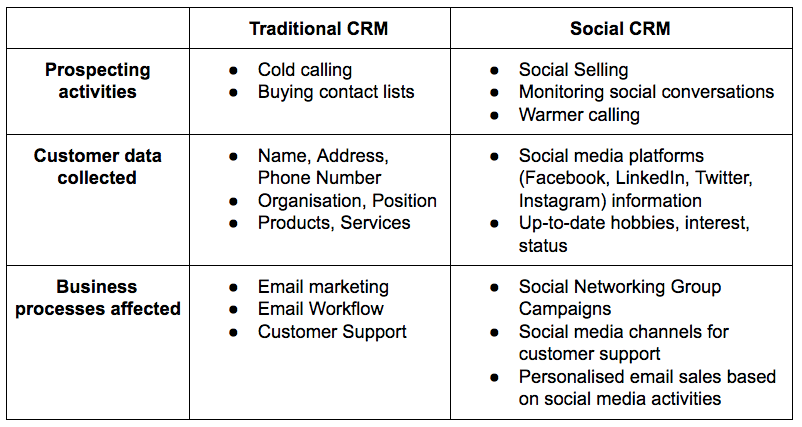Customer relationship management has been a trend endorsed by businesses of all calibres for a while. It’s effective, it’s easy to implement and it gives you a competitive advantage.
...but what if I said there’s something even better on the market?
That’s right! The world of technology is one speedy boy. It’s time to update your CRM knowledge and get acquainted with the newest addition to the CRM family -- Social CRM.
What Is Social CRM?
Social Customer Relationship Management (Social CRM) is the process of integrating social media channels such as Facebook, LinkedIn, Twitter and Instagram with CRM platforms.
Social CRM consists of the following core features:
- Customer profile analysis. By analysing your prospects’ social media profiles, you can build a customer profile. This allows for a better understanding of your target audience.
- Sentiment analysis. Offers insights into how your target audience feels about whatever issue you’re trying to learn more about.
- Social listening. Monitoring online conversations within your industry to identify pain points, opinions about your business and the products you offer.
- Social media management. Keeping in touch with your target audience through improving your online presence on social media platforms such as Instagram, Twitter, Facebook and LinkedIn can enhance brand awareness and brand loyalty.
- Social selling. Building strong relationships with your customers on social media platforms boosts your sales in the long run.
Social CRM Vs. Traditional CRM
At first glance, social CRM sounds awfully familiar. Isn’t it just regular CRM that focuses on social media interactions?
Well, yes and no.
Although social CRM strategy principles overlap massively with the principles of traditional CRM, there are some key differences. They’re rather subtle, but still make a lot of difference. The best way to show what the fuss is all about is to draw a side-by-side comparison.
As a high schooler, I dreaded tables. In adult life, especially in business, they’ve shown to be particularly useful for proving my point. Enjoy this neat table comparing social and traditional CRM attributes. Isn’t she a beauty?

A lot of key components intrinsic to traditional CRM are still present within the framework of social CRM. There’s a clear explanation for this, social CRM stemmed from traditional CRM and can therefore be considered a product of evolution.
If you paid attention in biology at high school, you should know that evolution is a good thing. It results in progress; organisms (in our case, concepts) are always getting better through evolution. To some extent, social CRM is a level up from traditional CRM.
Social CRM is more customer-centric. It relies less on pre-defined processes and more on dynamic changes in prospects’ online behaviour. The one fatal flaw of traditional CRM is the absence of synchronisation. Contact data is recorded once and gets updated manually, at random intervals, and not necessarily when changes occur. The chances of you mistargeting your message and reaching out to someone who is no longer interested in your offer are higher.
On the other hand, community management supplies social CRM with real-time records created by clients. That means it is always up-to-date and relevant. Social CRM allows for more flexibility than traditional CRM; you can bend your campaigns to fit the exact needs of your prospects, fostering customer satisfaction.
Why Implement Social CRM?
Increasing levels of customer satisfaction is just one of the many benefits of implementing social CRM. Let’s break down further advantages of getting a grip of social CRM:
- It allows you to learn your target audience better. Suppose you are constantly interacting with your prospects in their natural habitat, social media. You know what they want, how they feel, what inspires them and what bothers them. You gather richer, actionable insight about your customers as well as their sentiment about your company, your brand, and specific products or services.
- It empowers customer support and customer success teams. Tracking your target audience’s activity on social media provides your customer support and customer success staff with up-to-date information about what challenges your customers could face. Often, people complain about things that go wrong on social media; often, they go into detail about it. If your customer success team accesses these complaints before the customer reaches out to seek assistance first, you can establish yourself as a pro-active customer-centric company. The quicker you find out there’s a problem, the more time you have to solve it.
- It helps publish relevant and engaging content. Once you know what content is deemed valuable in the eyes of your customers, you can start giving it to them. Identify what your prospects are most interested in. Whether they like videos, long reads or short and sweet ‘how to’ posts, provide them with the stuff they want.
- It provides instant feedback on business performance. Gathering feedback is an essential part of improving your product. If you want to move forward, you need to understand and eliminate the factors that hinder your progress. The best way to spot those is by listening to your customers. A lot of people share impressions with friends and followers online. Social CRM allows you to increase the volume of the feedback you get your hands on; your analysis becomes more accurate.
- It boosts brand awareness. Social selling increases your brand’s online presence, leading to greater brand exposure. Suppose you’re successful in social selling endeavours, and your comments are relevant and helpful. In that case, you’ll get a lot of likes, reposts and other social engagement signals that’ll stimulate word-of-mouth marketing. According to statistics, companies that increase their social media output by 10% see a 7% increase in brand awareness. (Source: Zoho)
- It adds a human touch to your brand. Social CRM allows you to warm up your cold calling. If you’re familiar with what’s going on in your prospects’ lives from their social media updates, you can be more personal in your approach to them.
- It enables businesses to establish strong relationships with their customers. Overall, if you know lots about your customers, they’ll treat you as a trustworthy friend.
Who Can Benefit from Social CRM?
If you’re still not convinced whether you need social CRM or not, let me blow your mind. Social CRM is a multi-purpose strategy, which means several departments within your company can benefit from its implementation.
The Sales Team
Sales teams can reach out to prospects with more relevant and valuable offers. Based on the prospects’ social media updates, sales reps can better identify where exactly leads are within the sales funnel.
Social CRM increases customer loyalty by 55%, which amps sales revenue by 54%. (Salesforce)
Besides, social CRM can help you increase sales and revenue as more and more customers become brand advocates and recommenders.
The Marketing Team
Social CRM helps the marketing team lower costs of marketing efforts by increasing the brand’s visibility and reach. Besides, social CRM enables better, more accurate and relevant segmentation of the target audience, which further enhances the personalisation of experiences.
Dedicating as little as 6 hours a week to social media activity significantly reduces overall marketing costs. (Salesforce)
The Customer Support and Customer Success Teams
Customer Support and Customer Success departments can track customer activities and provide a more personalised approach to problem-solving and assistance. This drastically increases levels of customer satisfaction.
79% of customers believe that customer experience became better once social CRM was in force. (Salesforce)
How To Implement a Social CRM strategy
The best thing about social CRM is that it’s easy to implement, especially if it’s already integrated with the tools you already use. If you allocate a decent amount of time to its implementation, you run it almost flawlessly and without too much effort.
1 — Brief your Social CRM team
First of all, get your team in line. Onboarding staff and developing a robust strategy beforehand can boost productivity and ensure you implement social CRM smoothly. Before you embrace your social customer relationship management activities, you need to think about a style guide to provide consistent communication. Decide on the tone, the voice and other guidelines for how you handle customers.
To simplify the process of collecting mentions, you should come up with preliminary hashtags and keywords for outreach.
At first, you should focus on one social media platform and firmly establish yourself there. Discuss and assess all the advantages and disadvantages of different platforms to decide which one is the most appropriate for your business. You should consider the following factors.
- The pace of the social media environment
- Your target audience
- Your business niche.
Once you have a strong position on one of the social media platforms, you can expand and start practising a multi-channel approach.
2 — Stimulate thought exchange
Think about all the possible ways in which your customers can engage with your business. You want to ensure that communication is easy and accessible to all, so make it clear to your target audience that they can reach you via multiple channels.
- Enable private messages;
- Ensure your mentions and replies are on;
- Double-check your hashtags;
- Highlight your ‘Contact Us’ button on the website
3 — Automate your processes
Social CRM is easy because it can be automated. You don’t have to track all mentions manually. In fact you wouldn’t be able to pull that off even if you wanted to. The risk of missing a mention or two is too high, and ignoring your customers can have long-term negative consequences. If you don’t want to be slacking, consider using one of the various social CRM tools.
- NetHunt CRM. Fully integrated with Gmail. Great customer support. Just overall sexy. Free 14-day trial, $24 per user per month after that.
- Zoho. Established. Not fully integrated but offers a lot of features. $12 per user per month.
- Hubspot. Well-known. Multichannel. Customisable. Free.
- Salesforce Social Studio. Insightful. Offers online training. Fully customisable. Free trial, then $25 per user per month.
- Sprout Social. Has social CRM tools. Several social profiles at once. Customisable. $99 per user per month after the free trial.
4 — Analyse data and adjust your strategy
Last but not least, to get the most out of your social CRM strategy you need to ensure it’s dynamic and appropriate. One sure-fire way is to get into a habit of analysing data you collect throughout your campaigns and adjust your efforts accordingly.
Social CRM metrics to consider:
- Engagement. The number of likes, comments, shares and other social engagement signals indicates how successful your efforts are and how your publications are perceived by the target audience.
- Traffic. The amount of traffic generated from your social interactions helps to see which strategies work best and which ones need a bit more tailoring.
- Average response time. The average response time for the queries made by your customers helps to spot the most challenging issues they face and the solutions they are seeking. Besides, it helps to see which agents are more effective with which request.
- Buzz Levels. Which posts garner the most comments? Identifying the content that gets the most mentions and sparks the liveliest conversations helps you to see which topics your audience finds the most interesting.
- Followers Fluctuation. Tracking the number of followers can show you how you’re doing, but most importantly can provide you with information about how your target audience changes and grows.
- Backlog count. No matter how much effort you put into providing solutions to your customer queries, there are always a couple of odd ones out that don’t go as expected. Track the areas that need improvement and look into what causes stalling.
- Customer satisfaction score. Direct feedback from the customers regarding your performance can simplify the qualitative assessment of your social CRM efforts. Either that means randomly picking responses from the conversations or sending out questionnaires in bulk - you need to know what your customers think about their experience.
That’s it for now, but if anything even better than social CRM storms into the market, check NetHunt CRM first, we will be on it!
Table of Contents
Crack the sales formula with CRM Lab
Twice a month, receive actionable CRM content to your inbox.

